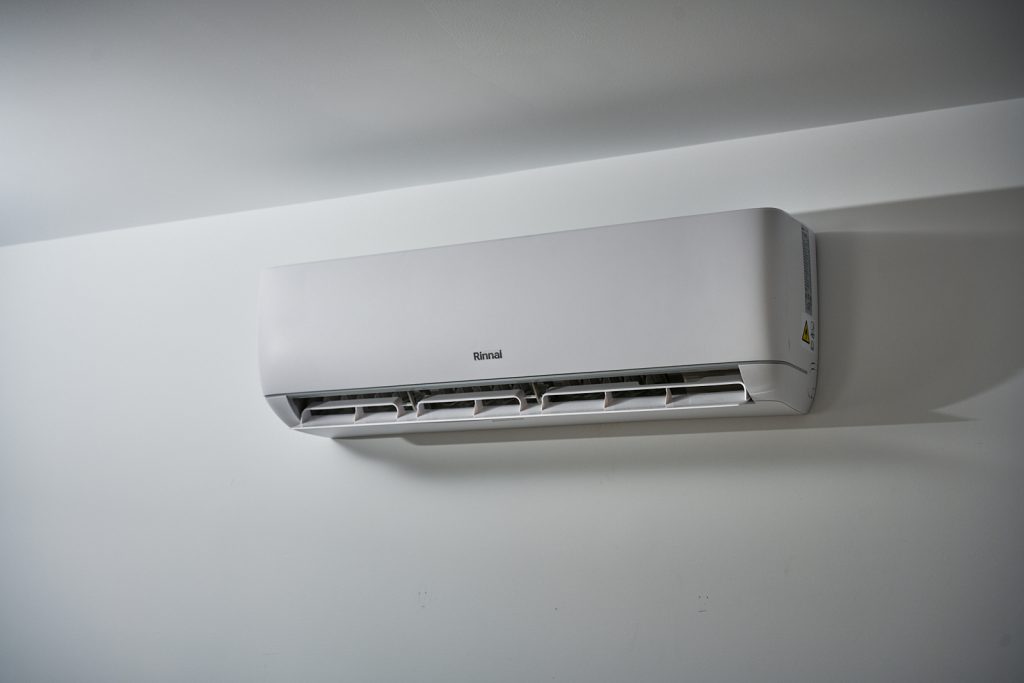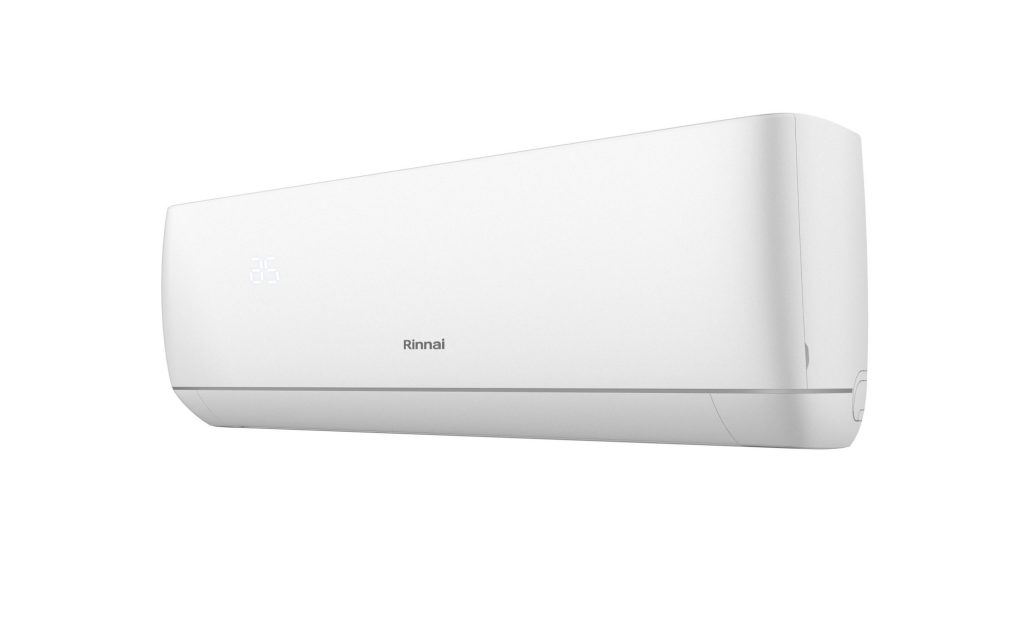
Same Name, Different Game: Which One Keeps Its Cool? 1. The Tale of Two Titans (Mitsubishi Electric vs Mitsubishi Heavy […]

In this article, discover the seven best Rinnai split systems for Australian homes, offering energy efficiency, comfort, and reliable performance for year-round climate control.
When the temperature is breaking records and making it uncomfortable for us to carry on with our routine, Rinnai Split Systems always come to the rescue.
With their flexibility and efficiency, split system aircons make heating and cooling convenient for many households and commercial spaces.
When it comes to cooling (and heating) Australian homes, Rinnai split systems are some of the most reliable and energy-efficient options on the market.
Known for their sleek design, quiet operation, and smart features, Rinnai units are ideal for every room size and climate zone.
The widespread use of split systems makes it clear that they are quite popular among Australians. To understand the reasons behind it, we must first understand what they really are.
A split system air conditioner is a versatile system usually with both heating and cooling capabilities. The reason it is known as a “split” system is that it comprises two primary parts: an indoor unit and an outdoor unit.
Since both units must be readily connected, the system’s design is ideal for heating or cooling a single room or any area that is positioned with access to an outside wall.
Two essential parts, known as the condenser and the compressor, are housed in the external (outdoor) unit. A set of insulated pipes carrying refrigerant connects this unit to the indoor unit and allows the system to transfer heat, enabling both cooling and heating.
Mounted on an interior wall, the indoor unit contains a cooling coil, air filter, and other essential parts that ensure adequate airflow while delivering cold, filtered air into the room.
When combined, these units effectively control the temperature in any given space.
In this guide, we’ll explore the seven best models in the J, T, and PB Series, with recommendations based on room size, energy performance, and use case.

The 2.5 kW J Series model is a standout for small bedrooms or home offices, with industry-leading energy efficiency and incredibly quiet operation.
One of the very few split systems marketed in Australia with a 9-star cooling rating (in hot climates), this equates to nearly unbelievably low operating costs. Even with its compact space-saving design, the unit features a series of smart capabilities like built-in Wi Fi, voice control, and a self-cleaning filter.
The unit is also made to operate effectively in hot outdoor temperatures—perfect for Queensland and WA houses where it’s hotter.
The indoor noise is low (as low as 22 dBA), so it’s ideal for operating at night.
Slightly bigger than the 2.5 kW model, the 3.5 kW model is perfect for large bedrooms or small lounges.
It still features all the advantages of the J Series, including its high energy rating, R32 refrigerant for enhanced environmental performance, and quiet performance.
The 3.5 kW model is the ultimate compromise for owners who want powerful cooling in a mid-sized area without a substantial power bill.
Designed for main living areas or medium-sized open-plan rooms, the 5.0 kW J Series system offers greater airflow and stronger temperature control.
It delivers solid performance during both summer and winter, thanks to its strong AEER rating. Like other J Series models, it comes with all the smart features you’d expect, such as app control, a timer, and auto-cleaning.
This product is particularly ideal for maintaining a steady climate in rooms that family members most frequently use.

For larger lounge rooms or large open-plan living areas, the 7.0 kW J Series system can handle it.
With excellent airflow of up to 15 m and rapid cooling or heating operations, it is designed to cut through more space efficiently.
Aside from its impressive power, it still operates quietly and includes all the same intelligent features as the compact J Series models. This system is ideal for homes located in areas with fluctuating temperatures or those that require constant entertaining in larger, open spaces.
The PB Series brings additional features to the table, particularly for households in coastal or high-humidity zones.
The 6.0 kW model includes Rinnai’s Gold Guard coating, which protects the outdoor unit against salt corrosion and rust. It also supports DRED (Demand Response Enabling Device), making it suitable for households participating in peak energy load programs.
With smart airflow control and a stylish indoor unit, the PB 6.0 kW model suits families looking for both performance and longevity.
This system is built on the 7.0 kW PB system but with increased power output for larger open areas or living rooms with heavy activity.
It comes equipped with all of Rinnai’s toughness and intelligence, along with better airflow control, a silent indoor unit, and stable temperature control. The PB 7.0 kW is a great do-it-all if you want a solid, reliable system for large areas in your home.
At the top of the PB range, the 8.0 kW model delivers maximum performance for very large open-plan living or even commercial spaces.
With DRED capabilities, a self-cleaning filter system, and corrosion resistance, this unit is ideal for homes exposed to coastal weather or requiring constant comfort year-round. If you’re looking for sheer power combined with smart efficiency, this model is the go-to solution.
| Model | Best Room Size | Cooling Rating | Airflow Reach | AEER / ACOP | Key Advantages |
| 2.5 kW J | 13–17 m² | 9 stars | Up to 15 m | 4.52 / 4.17 | Balanced for living areas, smart-controlled; energy-conscious |
| 3.5 kW J | 18–24 m² | 5.5 stars | Up to 15 m | ~4.4 / ~4.1* | Slightly more powerful; retains smart features; efficient for medium rooms |
| 5.0 kW J | 25–34 m² | 4.5 stars | Up to 15 m | ~4.52 / ~4.0* | Strong airflow, great for open plans; intelligent features included |
| 7.0 kW J | 35–47 m² | 4 stars | Up to 15 m | ~4.0 / ~3.9* | Corrosion-resistant, DRED enabled; smart filter cleaning |
| 6.0 kW PB | 30–40 m² | ~4 stars | 3D airflow | 3.42 / 3.85 | Corrosion-resistant, DRED-enabled; smart filter cleaning |
| 7.0 kW PB | 32–47 m² | 3.5 stars | 3D airflow | ~3.5 / ~3.7* | Stronger version of 6.0 kW; still coastal-safe and efficient |
| 8.0 kW PB | 40–54 m² | 3.5 stars | 3D airflow | ~3.4 / ~3.6* | Highest power; ideal for large open spaces; designed for long-term durability |
Choosing the right air conditioner depends on multiple factors, not just power output. Here are some key elements to guide your decision:
| Selection Factor | Why It Matters |
| Room Size vs Power | A too-small system will not cool efficiently; a too-large system wastes energy |
| Energy Efficiency | J Series units are extremely quiet, ideal for a bedroom or nursery |
| Smart Features | All models on our list feature Wi Fi, voice control, and timers for convenience |
| Airflow Reach | For open plans, greater airflow reach (15 m or more) offers balanced comfort |
| Noise Level | J Series units are extremely quiet, ideal for a bedroom or a nursery |
| Climate Compatibility | PB Series deals with coastal and humid climates with rust-proof coating |
| Grid Readiness (DRED) | PB Series allows peak-load management—ideal for energy-efficient homes |
| Warranty Support | Rinnai offers up to 7 years on parts/labour, ensuring long-term dependability |
Due to their economical, comfort-offering design, Rinnai split system aircons are a wise choice in a variety of environments.
For instance, the living rooms and slightly larger bedrooms of residential homes in Australia can be easily regulated for temperature with the Rinnai T Series or J Series Inverter Split Systems.
Their energy efficiency would help cut down your power bills, Wi-Fi connectivity makes them easy to operate, and their adaptability to different climate conditions would keep your homes comfortable all year round.
Even the Rinnai Q series would be ideal to use in residential homes, depending on the sizes of rooms and other requirements.
Since split air conditioners don’t use conventional ductwork to cool down a space, they are frequently referred to as “ductless air conditioners”. This makes them a practical and effective choice for many office settings.
Considering the Rinnai Split Systems specifically, the Rinnai D Series is ideal for small commercial spaces such as clinics, offices, and boutique stores.
It runs effectively and maintains employee and customer comfort throughout the day thanks to its high-capacity performance and sophisticated air purifying capabilities.
When it comes to apartments in Australia, the slimline indoor unit of the Rinnai T series makes it perfect for tighter wall spaces.
If you are looking for a reliable heating and cooling solution that does not take over your entire space in the apartment or require zoned comfort for different rooms, Rinnai’s Multi-Split systems would make an ideal choice.
These are ideal for home offices or homes with diverse comfort requirements because they enable several indoor units to be connected to a single outdoor unit, allowing you to customise the temperature in each space.
If you’re seeking quiet operation and premium efficiency for small rooms, the 2.5 kW J Series is unmatched.
For families cooling their living areas, both the 5.0 kW J Series and 6.0 kW PB Series provide reliable performance, with the PB Series adding extra durability for harsher environments. And if your home includes large open spaces, nothing beats the 7.0–8.0 kW models for powerful climate control.
Rinnai offers a huge range of models that provide robust performance while maintaining quiet and comfortable indoor environments, making them ideal for larger households.
Families that desire greater authority over the temperature in various rooms will find Rinnai’s systems to be dependable and energy-efficient.
A 2.5kW system typically suffices for modest bedrooms or studies (up to 20 square meters).
Systems with a capacity of 3.5-5kW are ideal for medium-sized spaces, such as living rooms or home offices. A 7.2 kW system is needed for larger spaces, such as open-plan living areas or those seeking a ducted alternative.
Very little. In most situations, all you need to do is clean the air filters every few months
and have them professionally serviced once a year. This maintains high efficiency and keeps minor problems from turning into expensive fixes.
Although previous purchases usually had a 5-year warranty, Rinnai now provides a 7-year parts and labour warranty on a wide variety of air conditioning systems, as of April 1, 2025.
The majority of certified installers can have a typical single split system operational in four to six hours.
The job may take a full day if it has complex wall runs, several units, or additional electrical work. It is important to choose a reputable installer to prevent delays and ensure that the warranty is upheld.
Since modern Rinnai inverter split systems change their output rather than continuously operating at full power, they are believed to be significantly more energy-efficient than earlier fixed-speed types.
However, several variables, including the unit’s size, the environment in which you reside, the degree of insulation in your house, and the way you utilise the system, affect operating costs.
Using economy mode or turning on the timer, keeping the filters clean, and selecting the appropriate capacity for your area can all help you keep your expenses low while staying comfortable all year long.